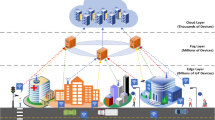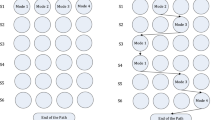Abstract
The development of Internet of Things leads to an increase in edge devices, and the traditional cloud is unable to meet the demands of the low latency of numerous devices in edge area. On the hand, the media delivery requires high-quality solution to meet ever-increasing user demands. The edge cloud paradigm is put forward to address the issues, which facilitates edge devices to acquire resources dynamically and rapidly from nearby places. However, in order to complete as many tasks as possible in a limited time to meet the needs of users, and to complete the consistency maintenance in as short a time as possible, a two-level scheduling optimization scheme in an edge cloud environment is proposed. The first-level scheduling is by using our proposed artificial fish swarm-based job scheduling method, most jobs will be scheduled to edge data centers. If the edge data center does not have enough resource to complete, the job will be scheduled to centralized cloud data center. Subsequently, the job is divided into same-sized tasks. Then, the second-level scheduling, considering balance load of nodes, the edge cloud task scheduling is proposed to decrease completion time, while the centralized cloud task scheduling is presented to reduce total cost. The experimental results show that our proposed scheme performs better in terms of minimizing latency and completion time, and cutting down total cost.













Similar content being viewed by others
References
Pan J, McElhannon J (2018) Future edge cloud and edge computing for internet of things applications. IEEE Internet Things J 5(1):439–449
Sharma SK, Wang X (2017) Live data analytics with collaborative edge and cloud processing in wireless IoT networks. IEEE Access 5(99):4621–4635
Du B, Huang R, Xie Z et al (2018) KID model-driven things-edge-cloud computing paradigm for traffic data as a service. IEEE Netw 32(1):34–41
El-Sayed H, Sankar S, Prasad M et al (2018) Edge of things: the big picture on the integration of edge, IoT and the cloud in a distributed computing environment. IEEE Access 6:1706–1717
Tang C, Xiao S, Wei X et al. (2018) Energy efficient and deadline satisfied task scheduling in mobile cloud computing. In: 2018 IEEE International Conference on Big Data and Smart Computing (BigComp), pp 198–205
Jian C, Chen J, Ping J et al (2019) An improved chaotic bat swarm scheduling learning model on edge computing. IEEE Access 7:58602–58610
Wang T, Wei X, Tang C et al (2018) Efficient multi-tasks scheduling algorithm in mobile cloud computing with time constraints. Peer-to-Peer Netw Appl 11(4):793–807
Meena V, Arvind V, Vijayalakshmi P et al (2018) Optimized task clustering for mobile cloud computing using Workflowsim. In: 2018 2nd International Conference on Inventive Systems and Control (ICISC), pp 1000–1005
Xu J, Hao Z, Zhang R et al (2019) A method based on the combination of laxity and ant colony system for cloud-fog task scheduling. IEEE Access 7:116218–116226
Zeng D, Gu L, Guo S et al (2016) Joint optimization of task scheduling and image placement in fog computing supported software-defined embedded system. IEEE Trans Comput 65(12):3702–3712
Yang Y, Wang K, Zhang G et al (2018) MEETS: maximal energy efficient task scheduling in homogeneous fog networks. IEEE Internet Things J 5(5):4076–4087
Jiang K, Ni H, Sun P et al (2019) An improved binary grey wolf optimizer for dependent task scheduling in edge computing. In: 2019 21st International Conference on Advanced Communication Technology (ICACT), pp 182–186
Hosseinimotlagh S, Khunjush F, Samadzadeh R (2015) SEATS: smart energy-aware task scheduling in real-time cloud computing. J Supercomput 71(1):45–66
Guo X, Liu L, Chang Z et al (2018) Data offloading and task allocation for cloudlet-assisted ad hoc mobile clouds. Wirel Netw 24:79–88
Aujla GS, Kumar N (2018) MEnSuS: an efficient scheme for energy management with sustainability of cloud data centers in edge-cloud environment. Future Gener Computer Syst 86:1279–1300
Fernando N, Loke SW, Rahayu W (2019) Computing with nearby mobile devices: a work sharing algorithm for mobile edge-clouds. IEEE Trans Cloud Comput 7(2):329–343
Chabbouh O, Rejeb SB, Choukair Z et al (2017) A strategy for joint service offloading and scheduling in heterogeneous cloud radio access networks. EURASIP J Wirel Commun Netw 2017(1):196
Feng J, Liu Z, Wu C et al (2017) AVE: autonomous vehicular edge computing framework with ACO-based scheduling. IEEE Trans Veh Technol 66(12):10660–10675
Wang T, Wei X, Liang T et al (2018) Dynamic tasks scheduling based on weighted bi-graph in mobile cloud computing. Sustain Comput Inform Syst 19:214–222
Jian C, Li M, Kuang X (2018) Edge cloud computing service composition based on modified bird swarm optimization in the internet of things. Cluster Comput 1–9
Alameddine A, Sharafeddine S, Sebbah S et al (2019) Dynamic task offloading and scheduling for low-latency IoT services in multi-access edge computing. IEEE J Sel Areas Commun 37(3):668–682
Li C, Bai J, Zhang L, Tang H, Luo Y (2019) Opinion community detection and opinion leader detection based on text information and network topology in cloud environment. Inf Sci 504:61–83
Chunlin L, Wang Y, Chen Y, Youlong L (2019) Energy-efficient fault-tolerant replica management policy with deadline and budget constraints in edge-cloud environment. J Netw Comput Appl 143(1):152–166
Chunlin L, Hezhi S, Chen Y, Youlong L (2019) Edge cloud resource expansion and shrinkage based on workload for minimizing the cost. Future Gener Comput Syst 101:327–340
Vashishth V, Chhabra A, Sood A et al (2017) A predictive approach to task scheduling for Big Data in cloud environments using classification algorithms. In: 2017 7th International Conference on Cloud Computing, Data Science and Engineering—Confluence, pp 188–192
Zong X, Jiang Y, Wang C (2016) Evacuation behaviors and link selection strategy based on artificial fish swarm algorithm. 2016 7th International Conference on Cloud Computing and Big Data (CCBD), pp 279–283
Majidi A, Polat H, Çetin A (2016) Finding a best parking place using exponential smoothing and cloud system in a metropolitan area. In: 2016 4th International Istanbul Smart Grid Congress and Fair (ICSG), pp 1–5
Youku: http://www.youku.com. Accessed July 2018
Neshat M, Sepidnam G, Sargolzaei M et al (2014) Artificial fish swarm algorithm: a survey of the state-of-the-art, hybridization, combinatorial and indicative applications. Artif Intell Rev 42(4):965–997
Shen H, Zhao H, Yang Z (2016) Adaptive resource schedule method in cloud computing system based on improved artificial fish swarm. J Comput Theor Nanosci 13(4):2556–2561
Hoang D, Dang TD (2017) FBRC: optimization of task scheduling in fog-based region and cloud. IEEE Trustcom/BigDataSE/ICESS 2017:1109–1114
Pham X, Huh E (2016) Towards task scheduling in a cloud-fog computing system. In: 2016 18th Asia-Pacific Network Operations and Management Symposium (APNOMS), pp 1–4
Rafique H, Shah M, Islam S et al (2019) A novel bio-inspired hybrid algorithm (NBIHA) for efficient resource management in fog computing. IEEE Access 7:115760–115773
Acknowledgments
The work was supported by the National Natural Science Foundation (NSF) under grants (Nos. 61873341and 61672397), Application Foundation Frontier Project of WuHan (No. 2018010401011290), and Open Project of Anhui Province Key Laboratory of Special Heavy Load Robot (TZJQR001-2020). Any opinions, findings, and conclusions are those of the authors and do not necessarily reflect the views of the above agencies.
Author information
Authors and Affiliations
Corresponding author
Additional information
Publisher's Note
Springer Nature remains neutral with regard to jurisdictional claims in published maps and institutional affiliations.
Rights and permissions
About this article
Cite this article
Li, C., Wang, C. & Luo, Y. An efficient scheduling optimization strategy for improving consistency maintenance in edge cloud environment. J Supercomput 76, 6941–6968 (2020). https://doi.org/10.1007/s11227-019-03133-9
Published:
Issue Date:
DOI: https://doi.org/10.1007/s11227-019-03133-9




